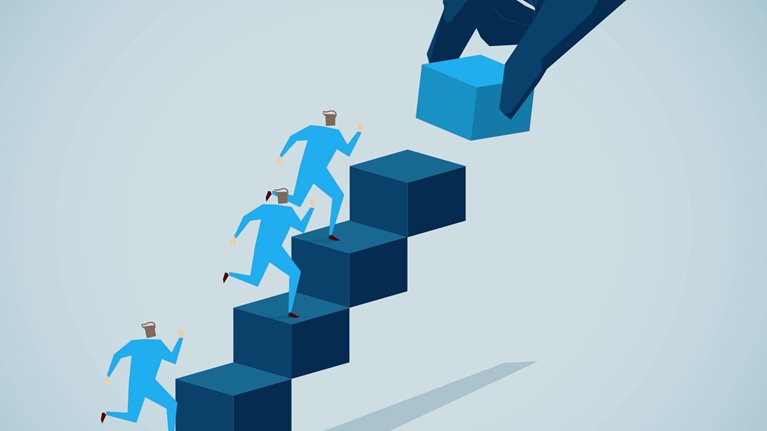Even before the COVID-19 pandemic, many Americans in need of public assistance struggled to determine their eligibility, navigate complex rules, or complete their applications.1 The pandemic increased demand and need in the United States, exacerbating these problems. The unwinding of the policies and flexibilities put in place via the federal Public Health Emergency (PHE) status—which included allowing a 6.2 percentage point increase in the federal Medicaid match rate—could further stress states’ eligibility systems and processes.2 States may consider exploring how they can help individuals not only as the pandemic and PHE wind down but also in the longer term.
An integrated benefit services delivery (IBSD) system, enabled by integrated eligibility systems and designed to improve access to public assistance across populations, could be an answer. We define IBSD as a way to streamline the entire life cycle for public-assistance benefits, such as healthcare, food, cash, childcare, and home energy benefits. An IBSD system may reduce the anxiety and conflict experienced by applicants as they try to determine their benefits. A streamlined application and approval process could help states clear their eligibility backlogs. States could consider allowing multiple offices to receive applicant data submitted through one portal, with a consolidated account management infrastructure.
Ultimately, an IBSD system could allow states to create more efficiency in staffing. This may include streamlined operations and administrative simplification—potentially freeing up staff time for additional management of complex beneficiary cases. With an IBSD system, states may find they are able to reduce their overall administrative costs even while allowing more of their residents to access benefits.
In this article, we examine the existing barriers for applicants and then discuss the elements that states could consider to help address these challenges. We also examine the impact of COVID-19, including how more public assistance became available during the pandemic, and discuss how a three-phase approach to implementing an IBSD system may lead to increased efficiency and access to care.
Challenges in applying for public assistance
The challenges for applicants receiving public assistance have long been documented. Historical roadblocks include challenges with compliance, awareness, and comprehension, including the following:
Compliance with varied administrative or program requirements. Applicants may find it challenging to determine what necessary documentation is needed for a program, how to submit that documentation, or how to determine specific deadlines. For example, Medicaid and the Supplemental Nutrition Assistance Program (SNAP) can have different timelines for renewal and recertification.3 Applicants may be asked to gather documents that include state identification, their Social Security numbers/cards, pay stubs, verification of child support, lease agreement, birth certificate, or medical bills.4 For example, in Louisiana those applying for the Kinship Care Subsidy Program and Family Independence Temporary Assistance Program would need proof of who lives in their home, such as school records or a landlord’s note. For SNAP, they would need to show medical expenses, such as pharmacy printouts, for the past three months. For all three programs, they would need the last four pay stubs, income tax returns, a termination notice related to employment, and any other proof of income, such as child support.5
Awareness. Individuals may not know that they qualify for social- and human-services programs offered by state and local county government agencies, such as subsidies for telephone or internet access. This lack of awareness may cause individuals to miss out on benefits that could aid their socioeconomic needs.6 These services often use public programs (for example, Social Security or Medicaid) as eligibility determination qualifiers.
Language and comprehension. Complicated jargon and policy-heavy terminology can make websites, applications, and notices difficult to understand. For example, SNAP eligibility may require applicants to understand the terms gross income, net income, and deductions, as well as which assets can count against eligibility (savings accounts) and which do not (property and, depending on the state, ownership of a car).7 Such obstacles may present barriers for people trying to apply.
How an IBSD system can be successful
An IBSD system could help address these issues and other problems that often slow the approvals process for applicants and could help to improve the customer experience and coordination of services.
The IBSD vision is already gaining traction in some states, but progress is slow. In 2018, McKinsey research found that only six states had started to integrate health and human services. Across these states, participation in a public program—such as Medicaid, Temporary Assistance for Needy Families, or SNAP—qualifies individuals for participation in other programs. Further, these states seek to ensure that applicants in need can get decisions on eligibility quickly and are directed to appropriate health and human services.
Even so, a variety of factors—such as missing information, human error, or changes in policy—could impact timely decisions for applicants. An IBSD system could improve customer experiences by enabling administrative transfers of eligibility data. Using this data could enhance coordination of services for an individual across multiple programs:
- Applicants could upload documentation once for use by multiple programs for verification purposes.
- Verification source checks could be automated so that the beneficiary is not burdened with providing updates.
- Applicants in one program can be screened for potential eligibility in other programs.
- Call-center workers, rather than on-site staff, can be trained to answer questions.
- Self-service functions can provide beneficiaries with access to information outside of traditional office hours.
This vision of IBSD is already gaining traction in some states. Maryland started a collaborative effort between the state comptroller’s office and Maryland Health Connection by offering to enroll residents in healthcare coverage based on information entered as part of their state tax returns.8 The Wisconsin Board for People with Developmental Disabilities launched a “family navigators” program to connect youth and families in need of support services with client resources.9
States’ introduction of low-code or no-code software solutions could also allow for substantially shorter development cycles and the ability to continually improve the applicant and enrollee experience. For example, California launched the GetCalFresh portal to simplify the SNAP application processes. By creating an applicant-centered interface on top of existing technology, the state shrank the time needed to apply for benefits from an average of 45 minutes to ten minutes.10
Other states may be able to make this type of improvement as they begin to examine shifts brought on by the COVID-19 crisis.
The impact of COVID-19
Between 5.3 million and 14.2 million Americans could lose Medicaid coverage when the COVID-19 PHE ends, which is currently expected to be mid-July 2022.11 During the height of the pandemic, more Americans became eligible for a wider variety of benefits. States now have an opportunity to reconsider the advantages of integrating their benefits services delivery systems.
Enrollment in Medicaid and the Children’s Health Insurance Program (CHIP) grew more than 30.5 percent between February 2020 and January 2022.12 While adult enrollment grew at a faster pace than child enrollment did, data suggest parents may have struggled to utilize benefits, even with coverage.13 For example, Medicaid and CHIP covered nearly 4.8 million children between February 2020 and January 2022, representing a 13.7 percent increase over 2019 levels.14 However, child screening services were provided in 21 percent fewer instances between March and October 2020 compared with the same period in 2019.15
The pandemic has also allowed some states to receive funding and modernize their legacy systems. For example, some states have leveraged Families First Coronavirus Response Act of March 2020 resources to provide pandemic-related expansions of electronic-benefits transfer (EBT) in the SNAP program.16 Pandemic EBT allowed SNAP recipients to receive benefits for children who would have normally received free or reduced-price school meals.17 The American Rescue Plan of 2021 increased SNAP benefits by 15 percent through September 2021 and distributed more than $360 billion in emergency funding for state, local, territorial, and tribal governments. President Joe Biden issued an executive order in December 2021 that, among other elements, called for a “no wrong door” approach that would allow streamlined enrollment for any eligible individual.18
As states prepare to emerge from the pandemic, they may consider reenvisioning their approach and creating an IBSD system. This shift may start with increased access and a streamlined common application.
Transitioning to the vision of IBSD
States may need to evaluate their people, policies, and processes when developing an IBSD system. When evaluating the benefits, it may also be helpful for states to determine the intensities of efforts in each of these focus areas.
While creating a robust system can take time, states could take steps to create a basic version. Consider a three-phase approach: first, focus on applicant-facing touchpoints, then update internal processes and technology solutions, and, finally, integrate staff and organizational constructs (exhibit). The latter components could deliver value at each phase and mitigate risks.

Phase one: Streamlining applicant- and enrollee-facing touchpoints
In this phase, states streamline the channels of engagement for all applicants, while temporarily retaining program-related internal business operations and technology systems as well as staffing and organizational structures. Elements may include an analysis of existing programs that could help states focus on the user’s journey; a self-service portal for applicants to find out the status of their enrollment or benefits; and an integrated consumer contact center that lets users conduct all transactions through a single phone number. A state could also create a common service center as a one-stop shop for applicants or allow them to upload photos of documentation and submit via their smartphones.
Potential benefits and implications of the first phase may include a more human-centered approach for applicants and cost savings for stakeholders. For example, states and payers could capture administrative efficiencies from the reduced cost of maintaining a single channel. In one mid-Atlantic state, the consolidation of call-center contracts across benefit programs was projected to provide between 20 and 30 percent cost savings.
Phase two: Integrated internal-operations and technology systems
Phase two focuses on creating a consistent eligibility determination process that lets applicants find out which services they can receive while saving time and reducing confusion. For example, one state Medicaid agency used agile and lean principles to reduce its eligibility backlog. By implementing a consistent process, the number of people waiting for applications and recertification determination declined by about 50 percent within three months, with the backlog projected to be fully eliminated within a year.
States in phase two may expand multichannel access for applicants who rely on technology. Mobile apps or web bots could suggest additional services an individual is eligible for and could allow those with specific needs, such as translation services, to have their questions answered. States may also use analytics and insights to provide information to help drive policy decision making. For example, utilization patterns of these services by beneficiary type could help inform benefit-design services for Medicaid Section 1115 waivers, home- and community-based services waivers, and more. Analytics enables longitudinal data collection and business intelligence, which could improve program integrity and reduce fraud.
The latter may also be an area to consider reinvesting some of the state’s savings. While outside the main scope of this article, states may have certain programs in which fraud guardrails have been looser. An IBSD system can allow the same standards to be applied across all programs.
The second phase could help to increase administrative savings through streamlining operations of contracts that are not at firm-fixed prices. This may potentially eliminate duplicative technology. This phase may also allow states to create end-to-end experiences with streamlined applications, eligibility, and benefits disbursement and improve insight into how beneficiaries use services.
However, states may want to consider overhauling their technology and business processes, given that benefits delivery is often run by different state agencies. Because streamlining business processes could require coordination across agency boundaries and among IT systems, this phase might include retraining county-level workers. Using a single eligibility verification hub to validate applicant information across multiple programs could require states to build new technology interfaces to legacy systems as well as redesign business processes related to the workflow of those verifying eligibility.
Another potential implication relies on treating data as modular information that could support the integration of technology solutions across multiple programs. This may allow for guidance to change within individual benefit programs without affecting the rest of the system.
Phase three: Full integration with integrated staffing and whole-system view
Once the technology has been integrated using web services, states may aspire to have full end-to-end integration of benefit services delivery with fully cross-trained staff who can manage the IBSD system.
In this phase, states could also work toward a comprehensive view of applicants. They could proactively offer benefits that are best suited for individual needs, which may potentially help avoid future adverse events for applicants and significantly reduce the cost of serving the population.
Potential benefits and implications of the third phase may include maximizing administrative savings across call centers, mail rooms, and with eligibility determination by using the same staff for multiple programs. For example, a Southwestern state undertook an agile method and a design-thinking approach to create about 50 human-centered future-state journeys prior to launching a technology project. By redefining its business processes, the state estimated a potential full-time-equivalent savings of 20 to 30 percent while improving resident experiences. Other potential benefits include helping beneficiaries receive the services they need, achieve better health, and avoid negative consequences as a result of unmet basic or healthcare needs. By creating a singular view of each applicant, each state may also improve program integrity.
States could consider the value of engaging frontline staff in transformations in order to be successful in the transition to an IBSD system. States may consider efforts in change management, at all stages of design and development, to ensure that staff at all levels are engaged and excited about the future vision. Personal, genuine commitment to change is a major component to employee buy-in.
Considerations for the path ahead
This three-phase approach is focused first on streamlining the application process. Next, it moves to integration in operations, and then addresses staffing and data, collectively helping states create a more efficient process. Many states are using the upcoming end of the PHE to collaborate across agencies in an effort to reduce the likelihood that those who need the critical safety-net benefits will experience an interruption of coverage due to confusion about the different requirements. This collaboration can be an accelerator in the journey toward integrated benefits service delivery. Removing red tape may help states reduce costs while creating improved experiences for residents (see sidebar, “Potential impact for beneficiaries”).
Ultimately, an IBSD system could improve beneficiaries’ lives and livelihoods. As states consider ways to strategize and create initiatives that respond to social determinants of health, examining current systems may be a place to start.


